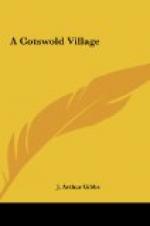This quaint old place appeared older than the rest of the buildings. On enquiry, I learnt that long, long ago, before the present manor house existed, this was the abode of the old squires of the place; but for the last hundred years it had been the home of the principal tenant and his ancestors—yeomen farmers of the old-fashioned school, with some six hundred acres of land. The present occupants appeared to be an old man of some seventy years of age and his three sons. Keen sportsmen these, who dearly love to walk for hours in pursuit of game in the autumn, on the chance of bagging an occasional brace of partridges or a wild pheasant (for everything here is wild), or, in winter, when lake and fen are frostbound, by the river and its withybeds after snipe and wildfowl—for the Cotswold stream has never been known to freeze!
In this small hamlet I noticed that there were no less than three huge barns. At first I thought they were churches, so magnificent were their proportions and so delicate and interesting their architecture. One of these barns is four hundred years old.
Fifty years ago, what with the wool from his sheep and the grain that was stored in these barns year by year, the Cotswold farmer was a rich man. Alas! Tempora mutantur, nos et mutamur in illis! One can picture the harvest home, annually held in the barn, in old days so cheery, but now often nothing more than a form. Here, however, in this village, I learnt that, in spite of bad times, some of the old customs have not been allowed to pass away, and right merry is the harvest home. And Christmastide is kept in real old English fashion; nor do the mummers forget to go their nightly rounds, with their strange tale of “St. George and the dragon.”
As I walk down the road I come suddenly upon the manor house—the “big house” of the village. Long and somewhat low, it stands close to the road, and is of some size. Over the doorway of the porch is the following inscription, engraven on stone in a recess:—
“PLEAD THOU MY
CAVSE; OH LORD.”
“BY JHON COXWEL
ANO DOMENY 1590.”
Underneath this inscription, and immediately over the entrance, are five heads, elaborately carved in stone. In the centre is Queen Elizabeth; to the right are portrayed what I take to be the features of Henry VIII.; whilst on the left is Mary. The other two are uncertain, but they are probably Philip of Spain and James I.




